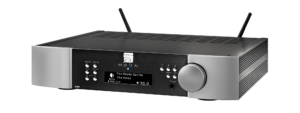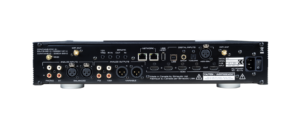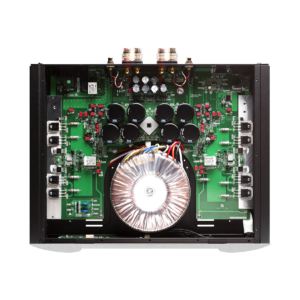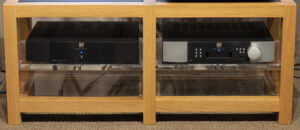
Moon 390D/330A streaming pre-amp & power amplifier

When it comes to versatility, the Moon 390 is something of a tour-de-force. This streaming preamp from Canadian company Sim Audio, has the lot: inputs for analogue sources, an MM/MC phono stage, integrated streaming (via wireless and wired Ethernet network), and digital inputs via USB, optical Toslink, SPDIF Coax, and four HDMI. Its natural partner is the Moon 330A stereo power amplifier, so we combined the two together with a pair of ProAc Response 30RS loudspeakers in one of our three demonstration rooms.

Moon streaming products from the all-in-one ACE through to the range-topping 780D all use the well developed MiND2 app, which allows access to streaming via Tidal (including MQA), Qobuz, Hires Audio and Deezer, plus internet radio and podcasts etc. via Tunein Radio, along with UPnP streaming of locally stored music.

We’ve stocked and admired Moon for a number of years, and we were immediately impressed with the sound delivered through the 390 and 330A via Qobuz, (with its wider choice of classical music, compared to Tidal). We were able to compare several different recordings of Beethoven’s 9th Symphony and were struck by how clearly the combination revealed the differences between them. The 390 and 330A are totally transparent with an extraordinarily low noise floor, allowing the listener to hear exactly what’s in the recording without veiling.
The Karrajan DG version was bright and dynamic – hugely exciting edge-of-the-seat stuff! Andris Nielsons conducting the Vienna Philharmonic (FLAC 96kHz) was nicely balanced, but not particularly stirring or immediate in presentation. Simon Rattle conducting the Berlin Philharmonic seemed to have the best overall combination of clarity and dynamism without brashness or harshness, however, this wasn’t a rose-coloured spectacle view but an ‘honest’ one, not seeming to emphasise or conceal anything. All versions were brought out cleanly as if viewed through an optical grade lens: supremely natural and dynamic whilst also being musically satisfying into the bargain. Clearly, the 390 is very capable streamer and the power amplifier has all the power, bass clout and dynamic capability one could want.
Changing genres, we listened to ‘It might as well be spring’ from Stacey Kent’s Dreamer in Concert.
Stacey’s voice was clear with closely detailed articulation, but without a hint of over-emphasis: intimately conveyed and simply lovely.
In ‘Postcard lovers’, from the same album (96kHz FLAC) her voice was equally seductive, the upright bass fluid and the snares clear and clean but without hardening, constriction or emphasis.
Prince’s ‘Purple Rain’ from Prince and the Revolution was simply explosive, and in his ‘Nothing compares 2U’ (both 96kHz FLAC) the rock-solid bass lines and crystal clear vocals were stunning.
Given the 390D carries HDMI inputs we wondered how good the sound might be via these, considering jitter can be an issue here. We need not have worried: playing SACDs via the HDMI output of an inexpensive Sony BluRay player (outputting DSD converted to multi-bit) was surprisingly good. We realised we could also play DVD Audio discs, so we dug out some old ones, and although this is a truly obsolete and not very usable medium, they too sounded remarkably good.

We then went all ‘Hi-Fi Shop’ and played ‘So What’ from Miles Davis’ Kind of Blue on SACD via the BluRay playerand were struck more than usual by the atmospheric, moody intro, with its subtle but clearly audible cymbals, the spitty sound of Miles’ trumpet and the free-flowing, firm, clear bass lines from the upright bass – even better, we felt, than we had heard via Qobuz!
Also stunning was Kodaly’s ‘Dances of Galentia’ (Sir Charles Mackerras conducting the Scottish Chamber Orchestra, Linn Records SACD) which was brought to life with unforced, clarity by the 390 and 330A combination. Acknowledging that the 390D has DSD capability, we set the Sony BluRay player to output DSD, and spinning Byron Janis playing ‘Rachmaninov’s Piano Concerto No 3’ on a dual-layer SACD/CD of an old Mercury Living Presence recording – first on a CD transport viaSPDIF, then as SACD set to multi bit and then with the BluRay player set to output DSD – at which point the display on the 390D showed the input as 2.8MHz DSD, confirming we had the real deal! At each step, the sound improved by degrees, becoming more and more analogue-like, further confirming the transparency of the entire set up and the stunning level of performance available with hi-res material.

The 390’s phono input is far more comprehensive than many outboard offerings, providing programmable gain, impedance and capacitance. We set it to 100 ohms, 60dB and 0 pico Farads (plus the arm lead capacitance) for use with an Ortofon Cadenza Red. There is even selectable equalisation with both RIAA and IEC, the latter including the extra low frequency time constant to reduce warp effects, etc. Impressive indeed for a non-optional internal phono stage.
With RIAA selected we played a selection of vinyl, including George Benson’s ‘On Broadway’ from Give me the night and ‘West End Girls’ from The Pet Shop Boys’ Please. Having played ‘On Broadway’ via Qobus this was a very interesting comparison – both were simply excellent, revealing the fine performance of the streaming and phono inputs. To finish off with a classical piece, we played Andre Previn conducting ‘Act1 one Scene 1’ from Prokofiev’s ballet Romeo and Juliet, which sounded beautifully lucid, with natural wood wind, strings, oboes, etc. and a lovely sense of acoustic.
The built-in phono stage is clearly not an afterthought but a very capable design which would compete favourably with many stand-alone phono pre-amplifiers, and it’s more versatile in adjustments than quite a few of them!
Summing up our thoughts, the Moon 390D and 330A really wowed us viaall sources, favouring no single musical genre over another. The pair proved to be great all-rounders capable of impressive transparency and musicality, whilst delivering plenty of clean, useable power for the D30RS to respond to over the entire spectrum, and really thriving on high resolution material. We firmly believe they can form a solid foundation for many a great system, and with their wealth of features, their overall ability and lack of tonal colour, they can easily be partnered with many different loudspeakers. One of very few systems with the potential to please many different people, and with an industry-leading ten year warranty, a very safe purchase!

